第九篇商城系统-商城首页功能
Posted 波波烤鸭
tags:
篇首语:本文由小常识网(cha138.com)小编为大家整理,主要介绍了第九篇商城系统-商城首页功能相关的知识,希望对你有一定的参考价值。

一、商品上架功能
ElasticSearch实现商城系统中全文检索的流程。

1.商品ES模型
商品的映射关系
PUT product
"mappings":
"properties":
"skuId":
"type": "long"
,
"spuId":
"type": "keyword"
,
"skuTitle":
"type": "text",
"analyzer": "ik_smart"
,
"skuPrice":
"type": "keyword"
,
"skuImg":
"type": "keyword",
"index": "false",
"doc_values": "false"
,
"saleCount":
"type": "long"
,
"hasStock":
"type": "boolean"
,
"hotScore":
"type": "long"
,
"brandId":
"type": "long"
,
"catalogId":
"type": "long"
,
"brandName":
"type": "keyword",
"index": "false",
"doc_values": "false"
,
"brandImg":
"type": "keyword",
"index": "false",
"doc_values": "false"
,
"catalogName":
"type": "keyword",
"index": "false",
"doc_values": "false"
,
"attrs":
"type": "nested",
"properties":
"attrId":
"type": "long"
,
"attrName":
"type": "keyword",
"index": "false",
"doc_values": "false"
,
"attrValue":
"type": "keyword"
2.netsted数据类型
参考官网地址:https://www.elastic.co/guide/en/elasticsearch/reference/7.4/nested.html
3.实现上架功能
3.1 创建ESModel
点击上架功能传递spuId到后台,我们需要根据SpuID查询对应的信息,然后封装到自定义的Model对象中,然后将该对象传递给mall-search服务,所以我们需要先定义这样一个Model对象
@Data
public class SkuESModel
private Long skuId;
private Long spuId;
private String subTitle;
private BigDecimal skuPrice;
private String skuImg;
private Long saleCount;
private Boolean hasStock;
private Long hotScore;
private Long brandId;
private Long catalogId;
private String brandName;
private String brandImg;
private String catalogName;
private List<Attrs> attrs;
@Data
public static class Attrs
private Long attrId;
private String attrName;
private String attrValue;
3.2 上架逻辑实现
/**
* 实现商品上架--》商品相关数据存储到ElasticSearch中
* 1.根据SpuID查询出相关的信息
* 封装到对应的对象中
* 2.将封装的数据存储到ElasticSearch中--》调用mall-search的远程接口
* 3.更新SpuID对应的状态--》上架
*
* @param spuId
*/
@Override
public void up(Long spuId)
// 1.根据spuId查询相关的信息 封装到SkuESModel对象中
List<SkuESModel> skuEs = new ArrayList<>();
// 根据spuID找到对应的SKU信息
List<SkuInfoEntity> skus = skuInfoService.getSkusBySpuId(spuId);
// 对应的规格参数 根据spuId来查询规格参数信息
List<SkuESModel.Attrs> attrsModel = getAttrsModel(spuId);
// 需要根据所有的skuId获取对应的库存信息---》远程调用
List<Long> skuIds = skus.stream().map(sku ->
return sku.getSkuId();
).collect(Collectors.toList());
Map<Long, Boolean> skusHasStockMap = getSkusHasStock(skuIds);
// 2.远程调用mall-search的服务,将SukESModel中的数据存储到ES中
List<SkuESModel> skuESModels = skus.stream().map(item ->
SkuESModel model = new SkuESModel();
// 先实现属性的复制
BeanUtils.copyProperties(item,model);
model.setSubTitle(item.getSkuTitle());
model.setSkuPrice(item.getPrice());
// hasStock 是否有库存 --》 库存系统查询 一次远程调用获取所有的skuId对应的库存信息
if(skusHasStockMap == null)
model.setHasStock(true);
else
model.setHasStock(skusHasStockMap.get(item.getSkuId()));
// hotScore 热度分 --> 默认给0即可
model.setHotScore(0l);
// 品牌和类型的名称
BrandEntity brand = brandService.getById(item.getBrandId());
CategoryEntity category = categoryService.getById(item.getCatalogId());
model.setBrandName(brand.getName());
model.setBrandImg(brand.getLogo());
model.setCatalogName(category.getName());
// 需要存储的规格数据
model.setAttrs(attrsModel);
return model;
).collect(Collectors.toList());
// 将SkuESModel中的数据存储到ES中
R r = searchFeginService.productStatusUp(skuESModels);
// 3.更新SPUID对应的状态
// 根据对应的状态更新商品的状态
log.info("----->ES操作完成:" ,r.getCode());
System.out.println("-------------->"+r.getCode());
if(r.getCode() == 0)
// 远程调用成功 更新商品的状态为 上架
baseMapper.updateSpuStatusUp(spuId, ProductConstant.StatusEnum.SPU_UP.getCode());
else
// 远程调用失败
二、三级分类数据
1.一级分类的数据
加载商城首页的时候就需要获取一级分类的数据
@GetMapping("/","/index.html","/home","/home.html")
public String index(Model model)
// 查询出所有的一级分类的信息
List<CategoryEntity> list = categoryService.getLeve1Category();
model.addAttribute("categorys",list);
// classPath:/templates/
// .html
return "index";
在Service中的实现
/**
* 查询出所有的商品大类(一级分类)
* @return
*/
@Override
public List<CategoryEntity> getLeve1Category()
List<CategoryEntity> list = baseMapper.queryLeve1Category();
return list;
然后在index.html中处理
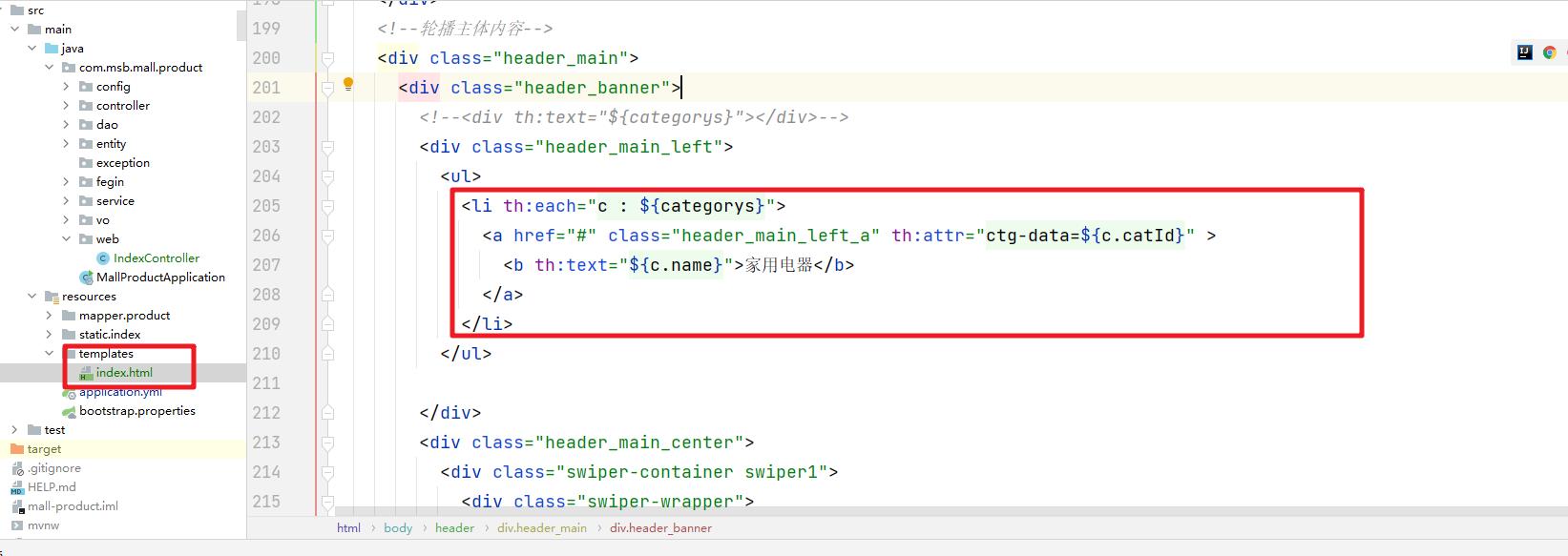
然后访问页面的效果
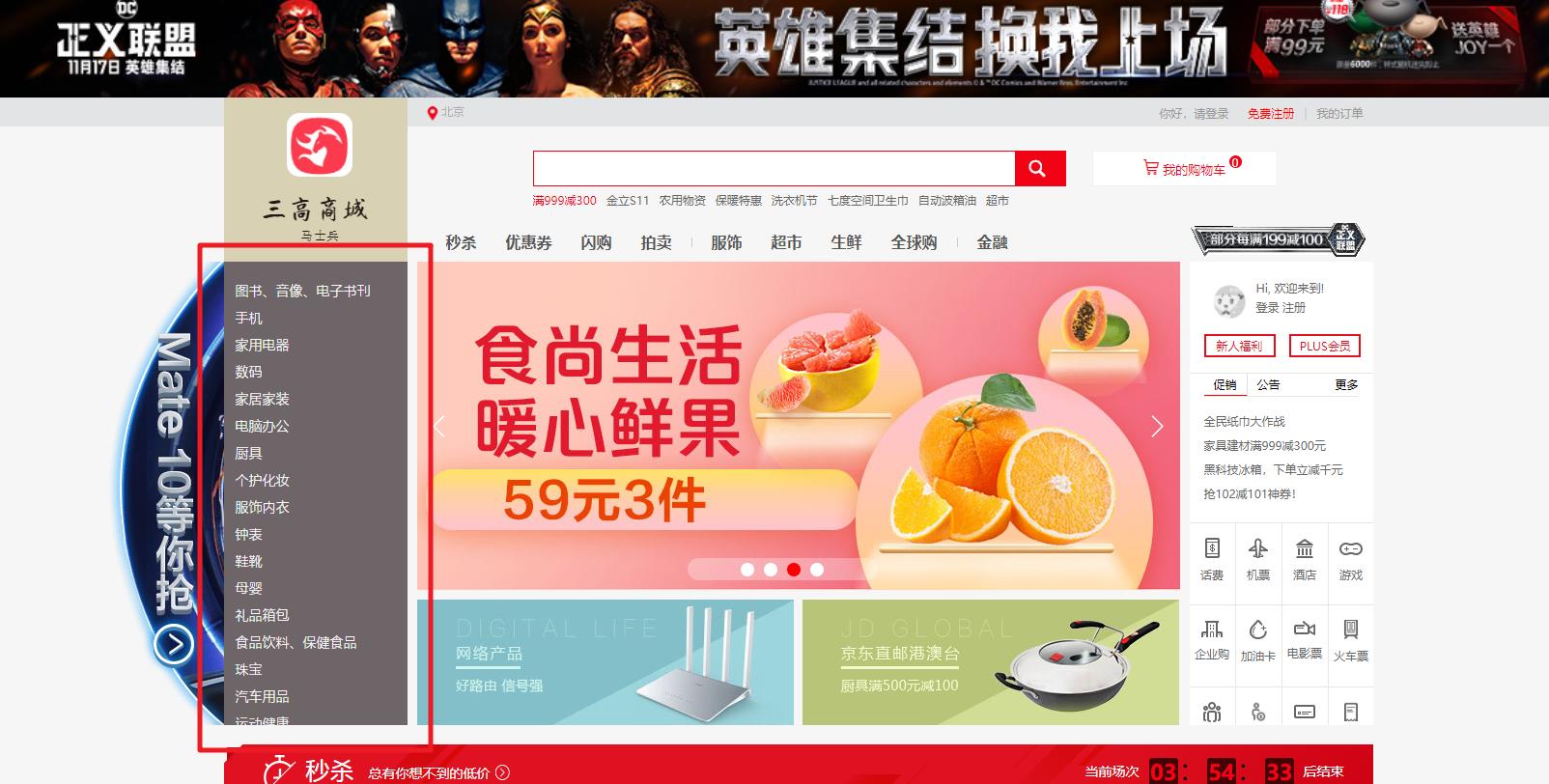
2.二三级分类数据
在默认的情况下其实加载的是写死的JSON文件
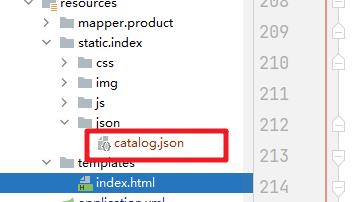
结合这个文件我们创建了对应的VO对象来封装对应的数据
package com.msb.mall.product.vo;
import lombok.AllArgsConstructor;
import lombok.Data;
import lombok.NoArgsConstructor;
import java.util.List;
/**
* 二级分类需要展示的数据VO
*/
@NoArgsConstructor
@AllArgsConstructor
@Data
public class Catalog2VO
private String catalog1Id; // 二级分类对应的一级父类的编号
private List<Catalog3VO> catalog3List; // 二级分类对应的三级分类的数据
private String id; // 二级分类的编号
private String name ; // 二级分类对应的类别名称
/**
* 三级分类
*/
@NoArgsConstructor
@AllArgsConstructor
@Data
public static class Catalog3VO
private String catalog2Id ; // 三级分类对应的二级分类的编号
private String id; // 三级分类编号
private String name; // 三级分类名称
然后我们在服务端查询对应的数据
@ResponseBody
@RequestMapping("/index/catalog.json")
public Map<String, List<Catalog2VO>> getCatalog2JSON()
Map<String, List<Catalog2VO>> map = categoryService.getCatelog2JSON();
return map;
然后在service中完成对应的逻辑
/**
* 查询出所有的二级和三级分类的数据
* 并封装为Map<String, Catalog2VO>对象
* @return
*/
@Override
public Map<String, List<Catalog2VO>> getCatelog2JSON()
// 获取所有的一级分类的数据
List<CategoryEntity> leve1Category = this.getLeve1Category();
// 把一级分类的数据转换为Map容器 key就是一级分类的编号, value就是一级分类对应的二级分类的数据
Map<String, List<Catalog2VO>> map = leve1Category.stream().collect(Collectors.toMap(
key -> key.getCatId().toString()
, value ->
// 根据一级分类的编号,查询出对应的二级分类的数据
List<CategoryEntity> l2Catalogs = baseMapper
.selectList(new QueryWrapper<CategoryEntity>().eq("parent_cid", value.getCatId()));
List<Catalog2VO> Catalog2VOs =null;
if(l2Catalogs != null)
Catalog2VOs = l2Catalogs.stream().map(l2 ->
// 需要把查询出来的二级分类的数据填充到对应的Catelog2VO中
Catalog2VO catalog2VO = new Catalog2VO(l2.getParentCid().toString(), null, l2.getCatId().toString(), l2.getName());
// 根据二级分类的数据找到对应的三级分类的信息
List<CategoryEntity> l3Catelogs = baseMapper.selectList(new QueryWrapper<CategoryEntity>().eq("parent_cid", catalog2VO.getId()));
if(l3Catelogs != null)
// 获取到的二级分类对应的三级分类的数据
List<Catalog2VO.Catalog3VO> catalog3VOS = l3Catelogs.stream().map(l3 ->
Catalog2VO.Catalog3VO catalog3VO = new Catalog2VO.Catalog3VO(l3.getParentCid().toString(), l3.getCatId().toString(), l3.getName());
return catalog3VO;
).collect(Collectors.toList());
// 三级分类关联二级分类
catalog2VO.setCatalog3List(catalog3VOS);
return catalog2VO;
).collect(Collectors.toList());
return Catalog2VOs;
));
return map;
修改js中的访问路径
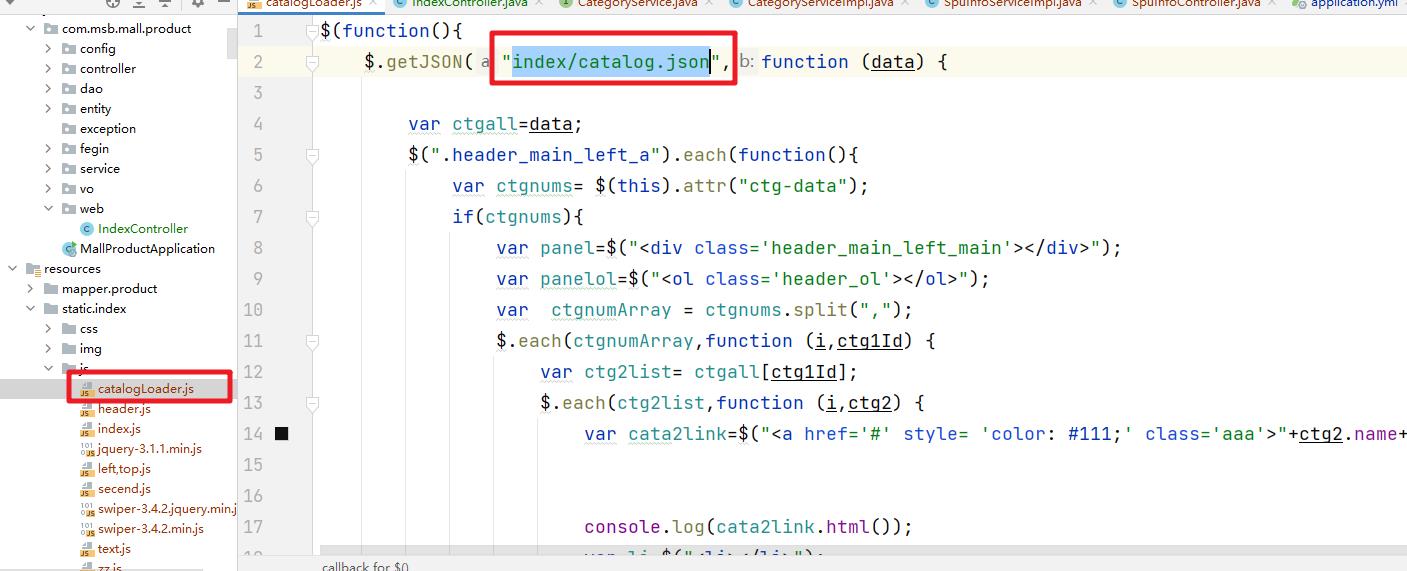
然后访问即可

三、nginx域名
1.hosts文件
在c:/window/system32/drivers/etc/hosts文件,我们在这个文件中添加
192.168.56.100 msb.mall.com
注意如果是没有操作权限,那么点击该文件右击属性,去掉只读属性即可
通过这个域名访问到Nginx服务
2.Nginx的方向代理


3.Nginx的负载均衡
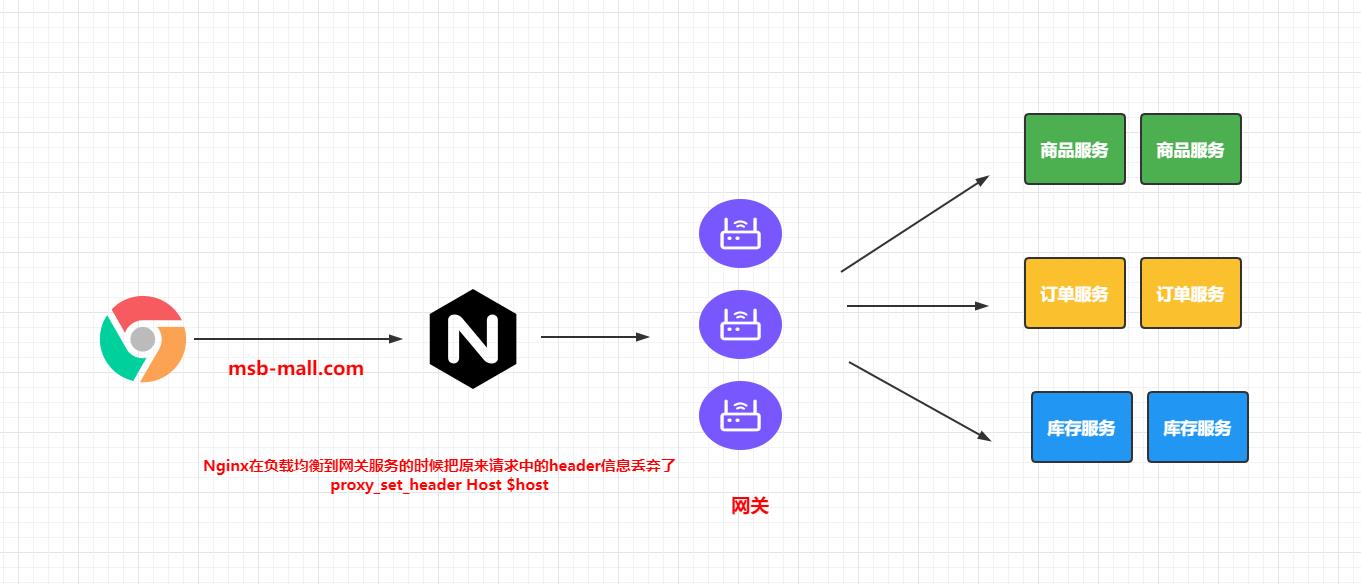
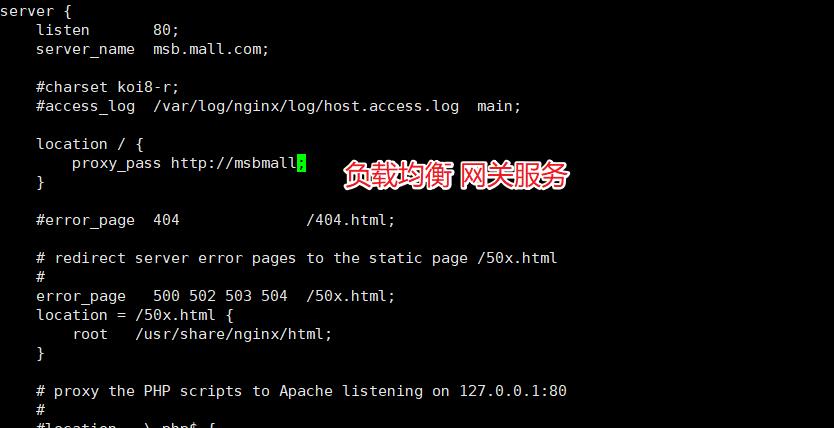
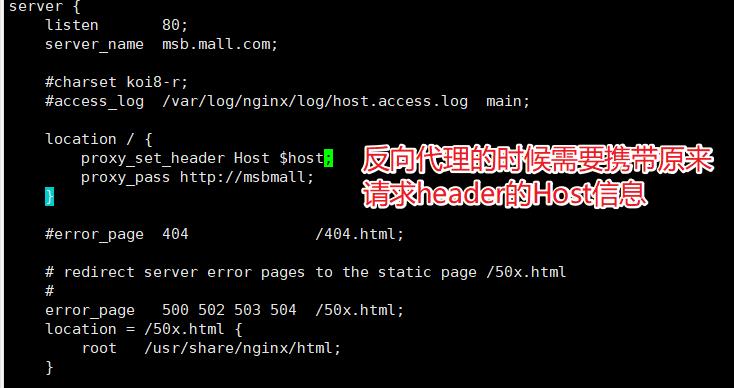
对应的需要修改网关的配置

然后即可通过域名来访问商城的首页

以上是关于第九篇商城系统-商城首页功能的主要内容,如果未能解决你的问题,请参考以下文章